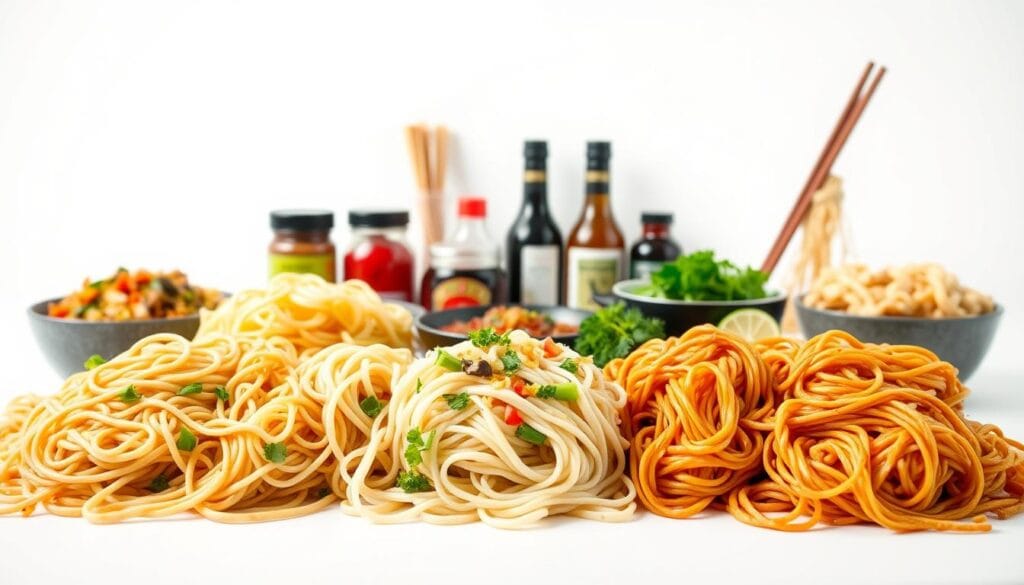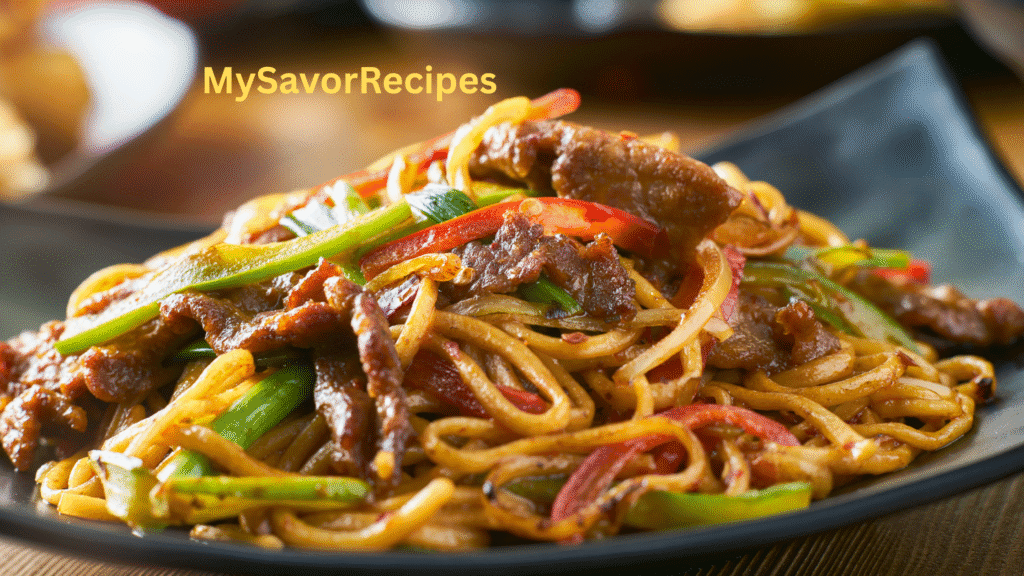Imagine coming home after a long day, feeling hungry for a tasty meal. SIMPLE STIR-FRIED NOODLES are here to save the day. They turn simple ingredients into a delicious dinner in just minutes, bringing Asian flavors to your kitchen.
Stir-frying is more than cooking; it’s an art that mixes speed, heat, and simplicity. It’s perfect for anyone, whether you’re busy, a student, or just need a quick dinner. These SIMPLE STIR-FRIED NOODLES will be your favorite for weeknight meals.
Key Takeaways
- Quick and easy meal ready in under 20 minutes
- Versatile recipe adaptable to various dietary preferences
- Authentic Asian-inspired flavor in every bite
- Minimal kitchen equipment required
- Nutritious and customizable meal option
Essential Ingredients for Perfect Stir-Fried Noodles
Starting with the right ingredients is key to making tasty stir-fried noodles. Choose high-quality items that add flavor, texture, and nutrition to your dish.
Noodle Selection Basics
Choosing the right noodles is crucial for a great stir-fry. Here are some top picks:
- Rice noodles – Light and delicate
- Egg noodles – Rich and chewy
- Wheat noodles – Sturdy and versatile
- Soba noodles – Nutty and nutritious
Sauce Flavor Foundations
A good sauce is essential for a flavorful stir-fry. Here are the main sauce ingredients:
- Soy sauce
- Sesame oil
- Rice vinegar
- Chili sauce
- Ginger and garlic
Fresh Produce and Protein Power
A balanced stir-fry includes fresh veggies and protein. Here are some great additions:
- Bell peppers
- Broccoli
- Carrots
- Chicken
- Tofu
- Shrimp
By picking these ingredients, you can turn simple noodle dishes into impressive homemade stir-fries.
Kitchen Tools and Equipment Needed
To make a real Asian noodle stir-fry, you need more than just the right ingredients. The right kitchen tools can make a big difference. They can turn your cooking into a top-notch experience.
The key tool for a perfect stir-fry is a high-quality wok. Woks made of carbon steel or cast-iron are best. They spread heat well and give your dish that special wok hei flavor. If you don’t have a wok, a big, heavy skillet works great too.
- Wok or large skillet with high sides
- Long-handled metal spatula or wooden cooking chopsticks
- Sharp chef’s knife for precise ingredient preparation
- Cutting board dedicated to vegetables and proteins
- Measuring cups and spoons for accurate seasoning
When picking utensils, look for ones that can handle high heat and give you control. A long metal spatula lets you toss ingredients fast without burning your hands. Wooden chopsticks are great for handling delicate foods.
Other tools like a kitchen timer, strainer for noodles, and prep bowls are also useful. They help you cook faster and more efficiently. With these tools, you’ll make delicious meals with ease.
SIMPLE STIR-FRIED NOODLES: Step-by-Step Guide
Making a tasty stir-fry noodle dish is easy. Just use the right techniques and practice a bit. This guide will show you how to make a great stir-fry noodle recipe that will wow everyone.
Preparing Your Ingredients
Good stir-frying starts with the right prep. Here’s what to do:
- Chop all veggies and proteins before heating the pan
- Measure out sauces and seasonings in advance
- Have your noodles cooked and ready to go
- Make sure all ingredients are cut the same size for even cooking
Mastering the Cooking Process
The secret to a great stir-fry is high heat and quick cooking. Use a wok or large skillet and follow these steps:
- Heat your pan until it’s smoking hot
- Add oil with a high smoke point
- Cook proteins first, then remove them from the pan
- Stir-fry veggies quickly to keep them crisp
- Put proteins and noodles back in the pan
Timing and Temperature Control
Timing is everything in stir-frying. Remember these tips:
- Cook each ingredient for no more than 2-3 minutes
- Keep moving ingredients in the pan
- Keep the heat high throughout cooking
- Add sauce at the end to avoid burning
With these tips, you’ll make a stir-fry noodle dish that’s as good as a restaurant’s. It’s full of flavor and ready in minutes.
Best Noodle Varieties for Stir-Frying
Choosing the right noodles can make your stir-fry amazing. Different noodles add unique textures and flavors. This makes picking the right one key for a great stir-fry.

- Egg Noodles: Thin, yellow noodles that soak up flavors fast
- Rice Noodles: Light and delicate, great for quick cooking
- Wheat Noodles: Strong and versatile for hearty stir-fries
- Udon Noodles: Thick Japanese noodles with a chewy feel
Your noodle choice affects your stir-fry’s taste and texture. Think about cooking time, flavor, and ingredient mix when picking.
| Noodle Type | Cooking Time | Texture | Best For |
|---|---|---|---|
| Egg Noodles | 3-4 minutes | Springy | Meat-based stir-fries |
| Rice Noodles | 2-3 minutes | Soft | Vegetable stir-fries |
| Wheat Noodles | 4-5 minutes | Chewy | Mixed ingredient stir-fries |
| Udon Noodles | 5-6 minutes | Thick | Robust protein stir-fries |
Pro tip: Cook your noodles a bit less than you think. They’ll cook more in the wok. This keeps them al dente and prevents them from getting mushy.
Secret Tips for Restaurant-Style Results
To make your stir-fried noodles taste like they’re from a restaurant, you need to learn some pro tips. Chefs use special methods to turn simple dishes into amazing meals.
The secret to great stir-fried noodles is knowing the small details that make a big difference. These details turn a regular meal into a special one.
Wok Hei: The Breath of the Wok
Wok hei is the smoky flavor that makes Asian cooking special. To get it, follow these steps:
- Preheat your wok until it’s very hot
- Use a high flame for quick cooking
- Quickly toss ingredients to get caramelization
Seasoning Secrets
Seasoning is key to making stir-fried noodles taste amazing. Chefs use a few tricks:
- They use old soy sauce
- Add a little oyster sauce
- Use fresh garlic and ginger
Professional Timing Tips
Timing is everything in stir-fried noodles. Here’s what experts say:
- Get all ingredients ready before cooking
- Cook proteins first
- Add veggies in stages, based on cooking time
- Keep cooking time under 5-7 minutes
By using these pro tips, you can make stir-fried noodles that will wow your family and friends.
Common Mistakes to Avoid When Stir-Frying
Making perfect SIMPLE STIR-FRIED NOODLES is more than just tossing ingredients in a pan. Many home cooks make mistakes that ruin a meal. These errors can turn a tasty dish into a disappointment.
Knowing these common mistakes can make your SIMPLE STIR-FRIED NOODLES better. Let’s look at the most common errors and how to steer clear of them.
- Pan Overcrowding: Too many ingredients in your wok or skillet stop heat from spreading. This leads to steaming instead of stir-frying.
- Incorrect Heat Management: Low heat means no wok hei flavor and soggy noodles.
- Inadequate Ingredient Preparation: Not chopping ingredients evenly can cause uneven cooking.
- Sauce Imbalance: Too much or too little sauce can mess up your SIMPLE STIR-FRIED NOODLES.
Getting good at stir-frying takes practice and focus. Prepare all ingredients before cooking, use high heat, and stir constantly.
| Mistake | Consequence | Solution |
|---|---|---|
| Overcrowded Pan | Steamed, soggy noodles | Cook in batches, use larger pan |
| Low Heat | Lack of flavor, mushy texture | Use high, consistent heat |
| Uneven Chopping | Inconsistent cooking | Cut ingredients uniformly |
Avoiding these mistakes will help you make top-notch SIMPLE STIR-FRIED NOODLES at home.
Customizing Your Stir-Fried Noodles
Easy stir-fry recipes are best when you make them your own. They can fit any taste and diet perfectly. Whether you’re cooking for vegetarians, meat lovers, or spice fans, stir-fried noodles are super flexible.
Vegetarian Delights
Making vegetarian stir-fries is easy. Swap meat for tasty plant-based options:
- Tofu cubes (extra-firm, pressed and marinated)
- Tempeh strips
- Seitan chunks
- Mushroom varieties like shiitake or oyster
Protein Power Variations
Adding protein can make your stir-fry amazing. Try these great options:
| Protein Type | Preparation Tip |
|---|---|
| Chicken | Slice thinly, marinate for 15 minutes |
| Shrimp | Devein and pat dry before cooking |
| Beef | Use flank steak, cut against the grain |
| Tofu | Press and cube for best texture |
Spice Level Adjustments
Getting the spice right is crucial. Start mild and build complexity. Here’s how to control the heat:
- Add chili sauce gradually
- Use fresh or dried chilies sparingly
- Balance heat with sweet or tangy ingredients
- Keep cooling elements like yogurt nearby
Remember, the goal is to make a stir-fry that delights your taste buds. Experiment, taste, and enjoy the journey!
Sauce Combinations and Flavor Profiles

Creating tasty quick noodle dishes begins with the right sauce. A good sauce can turn simple noodles into a gourmet meal in minutes. Knowing how to mix flavors lets you make dishes that excite your taste buds.
Different sauces can change how your noodles taste. Here are some classic sauce mixes to make your noodles better:
- Sweet and Tangy: Mix soy sauce, rice vinegar, and a bit of honey
- Spicy Kick: Blend sriracha, chili oil, and garlic paste
- Umami Rich: Combine oyster sauce, sesame oil, and grated ginger
Professional chefs say balanced sauces are crucial for great stir-fried noodles. When making your sauce, think about three main parts:
- Salt factor (soy sauce, tamari)
- Sweetness (sugar, honey, mirin)
- Acidity (rice vinegar, lime juice)
Try mixing these parts to make unique noodle dishes that you love. The trick is finding the perfect balance of each to get a great taste.
Make-Ahead and Storage Tips
Preparing a delicious homemade stir-fry in advance can save you time. It ensures you always have a quick meal ready. Proper storage techniques are crucial for maintaining the flavor and quality of your dish.
Your homemade stir-fry can be a convenient meal option when stored correctly. The key is to understand the best preservation methods. These methods keep your noodles tasting fresh and appetizing.
Proper Storage Methods
Storing your homemade stir-fry requires careful attention. This prevents soggy noodles and maintains optimal taste. Here are some effective storage strategies:
- Cool the stir-fry completely before storing
- Use airtight containers with tight-fitting lids
- Separate sauce from noodles when possible
- Refrigerate within two hours of cooking
Reheating Guidelines
Reheating your homemade stir-fry can be tricky. But these methods will help you restore its original flavor and texture:
| Reheating Method | Recommended Technique | Time |
|---|---|---|
| Skillet | Add small amount of oil, stir frequently | 3-4 minutes |
| Microwave | Use medium power, stir halfway | 1-2 minutes |
| Oven | Cover with foil, use low temperature | 10-15 minutes |
Remember, fresh is always best. But these storage and reheating techniques will help you enjoy your homemade stir-fry for up to 3-4 days when stored properly in the refrigerator.
Pairing Suggestions and Side Dishes
Adding the right side dishes and drinks can make your Asian noodle stir-fry even better. The perfect pairings can balance flavors and make your meal more enjoyable.
Here are some classic pairings that go well with your Asian noodle stir-fry:
- Crisp vegetable spring rolls
- Light cucumber salad
- Steamed edamame
- Pickled vegetable sides
Choosing the right drink is also important. Different drinks can bring out the best in your Asian noodle stir-fry:
| Beverage Type | Flavor Complement |
|---|---|
| Green Tea | Cleanses palate, reduces oiliness |
| Light Lager | Cuts through rich stir-fry flavors |
| Jasmine Tea | Enhances subtle spice notes |
If you want to try something new, sake or a crisp Riesling can be a great choice. The goal is to find the right balance of flavors and textures for a memorable meal.
Pro tip: Always serve side dishes in small portions to avoid overwhelming the primary stir-fry dish.
Health Benefits of Homemade Stir-Fried Noodles
Your stir-fry noodle dish is more than tasty—it’s packed with nutrients. It’s a meal that fuels your body and pleases your palate. When made with care, it’s a mix of good stuff that’s great for you.
This homemade dish has many health perks. Let’s look at why it’s a smart pick for your meals:
- High protein content from lean meats or tofu
- Rich in essential vitamins from fresh vegetables
- Controlled sodium and fat levels
- Balanced macronutrient profile
Nutritional Breakdown
Depending on what you add, a stir-fry noodle dish can have:
- Protein: 15-25 grams per serving
- Carbohydrates: 30-40 grams
- Healthy fats: 10-15 grams
Dietary Considerations
Your stir-fry noodle dish can fit many diets. For gluten-free, use rice noodles or zucchini noodles. If you’re watching carbs, try cauliflower rice or shirataki noodles.
By watching your portions and choosing the right ingredients, you can make this dish a key part of your wellness plan.
Conclusion
Making basic stir-fry noodles at home is easier than you might think. This guide has shared techniques and tips to help you. You can turn your kitchen into a stir-fry station with practice and understanding.
Your journey into basic stir-fry noodles doesn’t end here. Each time you make this meal, you’ll find new ways to make it your own. Try different noodles, sauces, and proteins to match your taste. The skills you learn will help you make many delicious dinners.
Mastering stir-fry is about being confident and creative. Start with the basics, then let your creativity shine. Your homemade stir-fry noodles can be as good as restaurant food if you follow the tips and avoid mistakes. Enjoy the learning process and have fun exploring stir-fry cooking.
We invite you to start your stir-fry adventure today. Share your creations with friends and family. Don’t be afraid to add your own twist to these basic stir-fry noodles. Happy cooking!

